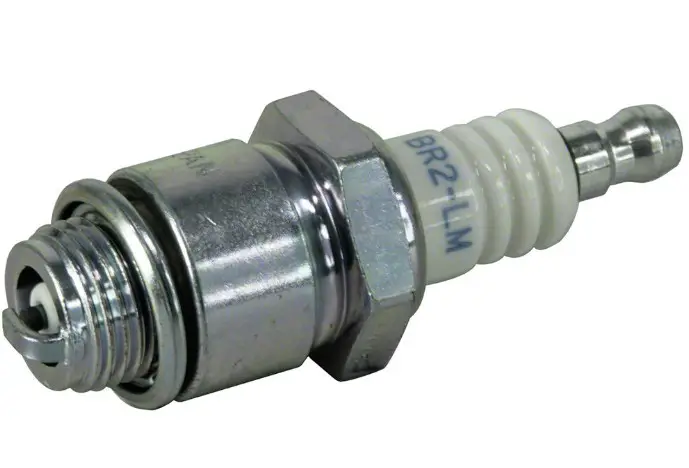I’ve recently been putting together a series of articles all about lawn mower spark plugs, and a running theme throughout most of them is something called the spark plug gap.
Now, I’ve not delved into this topic in great depth before because it deserves an article all of its own, so you can understand why a spark plug gap is so important, whether or not a lawn mower spark plug is pre gapped, and what to do if the correct spark plug gap isn’t as it should be.
Basically, I want to teach you everything there is to know about a lawn mower’s spark plug gap, so you can understand your lawn mower engine better, and fix any problems that should arise with the gap spark plugs are supposed to have.
SO, ARE SPARK PLUGS FOR LAWN MOWERS PRE GAPPED?
Yes, today spark plugs for lawn mowers are usually released pre gapped, because the spark plug gap is so integral to making sure you can start your lawnmower engine, and that the running engine can keep running.
Manufacturers send most lawnmower spark plugs to market pre gapped for convenience, so you don’t have to mess around with the engine when it arrives – the gap is exactly as it should be and the spark plugs can work as they should.
But things can go wrong (and they go wrong often) so as well as talking more about the importance of the right spark plug gap today, I’ll also look at how to double check that you have the right gap before starting your engines.
Ready to find out more? Then join me below.
Your Spark Plug Gap Explained
Spark plugs are rather simple devices operating in a highly complex mechanical engine that rely almost exclusively on electricity to run.
As you’ll already know, most spark plugs work when electricity generated at the ignition coil sends a charge from the spark plug’s center electrode to the ground electrode. The center and ground electrodes are essential in starting the engine.
The center electrode takes the electricity that’s activated when the ignition system is activated (i.e. you turn the lawn mower key, or pull on the start rope) and sends it across the spark plug gap to the ground electrode.
As this happens, a high potential difference is created, and this generates electricity that will cause an electric spark. The spark begins the combustion process in the combustion chamber by burning the air fuel mixture within.
It is this burning that gets the mechanical parts of the engine in working order, which then allows the lawnmower blade to cut, and the engine to continue running as the cycle repeats and the lawnmower can continue in a perpetual motion until the engine is turned off.
But What Happens If The Spark Plug Gap Isn’t Correct?
If the current spark plug gap isn’t exactly as it’s supposed to be according to the engine owners manual, then you’ll notice a few different problems.
ENGINE STRESS
If there is too much space or not enough space between the center electrode and the ground electrode, then the engine will need to work harder to create the spark between the two electrodes.
Although most lawnmowers will have a spark plug gap that is correctly set beforehand, this can be moved accidentally during shipping or otherwise changed during use (but more on this later).
If the gap is too large, the engine will work harder to burn the fuel mixture, and if the gap is too small, there might not be enough room for a spark to be created at all, meaning the engine just won’t start.
In many ways, it’s worse for the gap to be too large, though, as the engine will still be able to operate, but the added stress can cause internal engine damage. This sort of damage is common on outdoor power equipment, because many owners think that if the lawnmower is running, then it must be fine. The result? Without the proper gap, your engine could break beyond repair.
ENGINE MISFIRES
Misfires in the engine (specifically the cylinder housing) can occur when the specific width the lawn mower spark plugs gaps are supposed to be aren’t met.
The correct width for each model varies depending on the engine model used, etc., but you can find your exact requirements in the owner’s manual to find all the details you need for your push along lawnmower or vehicle’s recommended setting.
When it isn’t the correct width, engine misfires can occur, meaning it takes a long time for your engine to start, or it will cut out intermittently when in use, depending on your engine type and how poor the spark plug gap is compared to what it should be.
SPARK PLUG WEAR
When installing spark plugs, you have to take extra care to ensure the gap is right. If it’s wrong, then it can lead to spark plug wear, which will then mean you need to replace the old spark plug with a new spark plug much quicker than you ordinarily would.
Again, this comes back to how hard your engine and spark plug have to work when the gap isn’t correct, causing low power over time, or even the engine to break altogether.
What Can Cause Your Pre Gapped Spark Plug To Go Wrong?
I’ve talked about what happens when things go wrong, but what actually causes it to begin with? If manufacturers send out lawn mower spark plugs pre gapped, then what’s causing them to change?
Well, it’s typically for two main reasons:
Shipping
I’ve touched on this already, but it’s one of the most common reasons your lawn mower won’t start when you first get it from the store or have it delivered to your house.
Whilst manufacturers do pre gap spark plugs using a spark plug gap tool or spark plug gauge (A.K.A. a feeler gauge) to make sure they’re perfect, lawn mower spark plugs can be knocked around during shipping. It’s all too easy for the gap to gently bend out of shape, causing the lawn mower spark plug gap to be off ever so slightly. This can lead to the mower performing poorly with lower power, overuse of fuel, etc., or else not starting at all.
Use Over Time
Faulty gaps can occur due to engine heat over time. The heat can cause the ground electrode to move or be eaten away slightly, causing the usually flat, round piece to be misshapen.
This only worsens as the anode gets thinner. The anode, for those of you that don’t know, is a small post covered by a metal tongue at one end of the spark plug – typically found inside the cylinder housing. This anode has the post and the tongue (center and ground electrode), and you can actually manipulate the anode using a spark plug gap tool to adjust it to the correct width.
And doing so is fairly simple…
Adjusting Your Lawn Mower Spark Plug Gap
WHAT YOU’LL NEED
- Spark plug wrench or spark plug socket
- A spark plug gap tool or feeler gauge or gap gauge
THE METHOD
Getting into your lawn mower engine is easy enough with a spark plug wrench or socket because they’re specifically designed to untighten the spark plug so you can manipulate it as you require for a gap adjustment using a gapping tool.
Once loose, just remove it from the correct wire and you’ll be able to use the gap tool to adjust the gap.
Please note: You’ll need to be precise with this task. Only ever stick to the advice in your owner’s manual, or else you may force the gap too wide or leave it too narrow, and you’ll be back to square one again with a lawn mower that performs poorly or doesn’t work at all due to a faulty spark plug gap.
Final Thoughts
Although lawn mower spark plugs are pre gapped, it’s helpful to know the signs that a spark plug gap is faulty so you can fix the issue yourself with an inexpensive gap gauge.
Just remember to consult your owner’s manual, be precise with your measurements, and you should have a spark plug gap that allows the mower to start and continue to run as the combustion cycle repeats itself.
But with mower spark plugs coming with a pre prepared gap to start with, you might get lucky and never need to alter the gap at all until it’s altered over time with continued use.
Now you know everything there is to know about a spark plug gap, I hope you’ll be able to combat any problems should they arise!


